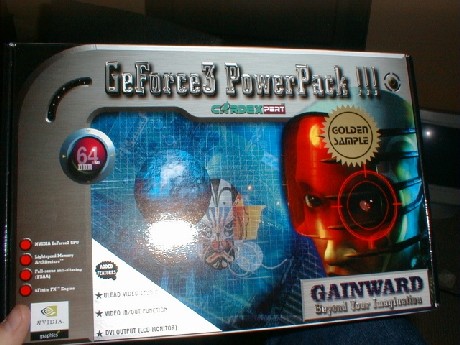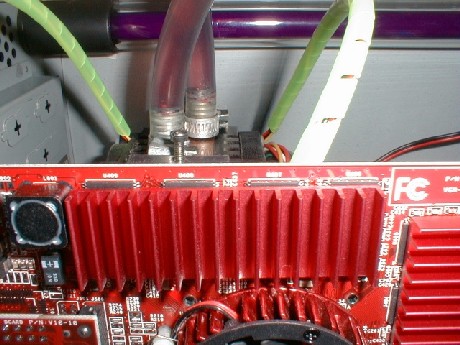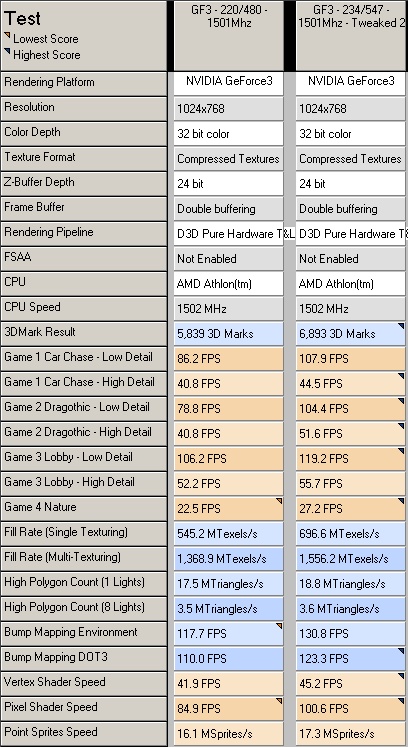Gainward Golden Sample GF3
|
Introduction NVIDIA's GeForce3 chip and cards based around it are now well established. Cost is still high compared to other competing cards, but despite such a limitation, the gaming and performance graphics world have taken to the GeForce3 in a big way. There is no doubting its performance, that's for sure. The GeForce3 GPU is a 256-bit processor with 57 million transistors making it more complex than a Pentium 4. 128-bit memory interface to extremely fast DDR memory. Memory bandwidth of 7.36Gb per second at the default memory speed. Then there's the programmable aspect. NVIDIA lets the programmer directly program the graphics pipeline of the GeForce3 to offer potentially unlimited effects. Called the nFiniteFX engine, it provides the support for DirectX 8's pixel and vertex shaders and lets OpenGL access the functionality via extensions. The programmer has power to control the GPU and program his or her own effects into the graphics pipeline and isn't stuck with the effects the chosen API gives them. This opens up a whole new world of graphics programming and we'll see this programmability available in all new consumer parts in the future. Next up is their Lightspeed Memory Architecture. Featuring in the new Xbox as well as the GeForce3, LMA is NVIDIA's attempt at solving the memory bandwidth problem facing graphics cards, much like ATi with the Radeon and HyperZ. Current graphics GPU's are incredibly fast. They can process massive amounts of data but current memory technologies still struggles to keep up. Increasing the memory clock speed increases the memory bandwidth. This helps a lot with current GPU's, something which Gainward sells this GeForce on the back of. LMA decreases the amount of work the AGP bus has to do when shifting vertex and pixel data from main memory to the card memory. It attempts to do intelligent memory access on chip, reducing the strain on AGP. It's a combination of a new memory crossbar between the GPU and card memory, along with some clever tricks when working with data that achieve this problem and help keep memory bandwidth issues to a minimum. The 7.36Gb per second limit still exists, just the GPU does a lot more with it and is more efficient. Lastly on NVIDIA's list of top features is FSAA (full scene anti aliasing) or HRAA as NVIDIA like to call it (high resolution anti aliasing). It is basically a way of quickly multisampling a scene, combining those samples and then displaying them in a way which eliminates pixel artefacts such as jagged edges. All those features and more, combined give the GeForce3 the current edge over the competition. ATi's new r200 core is hot on the heels of the GeForce3 and offers performance improvements. I'm sure NVIDIA have a trick or two up their sleeves to keep the GeForce3 at the top, plus the GeForce3 Ultra is on the horizon. Like everyone apart from Asus it seems, Gainward have stuck faithfully to the NVIDIA reference design for their GeForce3. The PCB layout is familiar and the memory chips are the same 3.8ns EliteMT chips we are used to on current GeForce3's. Here is a quick list of the important features on the Gainward to give you an idea of the power and features this card has. Being the VIVO version, it's absolutely stuffed to the brim with extras. · NVIDIA GeForce3
GPU It utilises the daughter card approach to VIVO using the Philips decoder and it seems to work well. TV-Out was fine and looked very good in terms of quality, probably a good touch better than the Brooktree chips I'm used to having on NVIDIA cards. I was unable to test video capture in time for this review but I'll be revisiting this card at a later date when the Detonator 4 drivers are released and I'll include video capture results in that write up. To aid in the video side of things you get a copy of Ulead VideoStudio 5.0 SE on CD in the box, along with the other 3 CD's with drivers, utilities (including Adobe ActiveShare and 3Deep software) along with a copy of WinDVD for playing DVD's. The software bundle is useful and I'd rather see application software than games bundled with a video card. Overall, a quality software pack with the Gainward. When you've got past the features, the software and actually get round to installing the card, one thing hits you. The Gainward is red, bright red. Right down to the heatsink and memory ram sinks. Even the daughter board uses the same red PCB as the main board. It certainly stands out and I like it. With Hercules shipping blue everything, and people like Abit getting in on the act with its black MX400 and blue KT7E motherboard, it's nice to see more companies distinguish their product sets and appeal to the case modding scene. As I mentioned in my Abit MX400 review, more and more people are modifying their cases with windows, lights etc. The red PCB of the Gainward is certainly something to show off. Not to everyone's taste for sure, but definitely to mine.
So we've established that the Gainward CARDEXPERT GeForce3 Power Pack Golden Sample VIVO (eh?!) is packed with features, how does it perform. Performance and Overclocking I'm hoping you noticed the Golden Sample in the product name above. Gainward sometimes sells different versions of it's graphics cards, designating some cards Golden Sample. Golden Sample is Gainward's way of telling you that the card you own is certified to run at higher speeds than the stock cards. In this case, where the regular Power Pack is clocked at the reference speed of 200Mhz core and 460Mhz memory clock, the Golden Sample is certified to run at 220Mhz core and 480Mhz memory. Gainward provides you a utility to set the enhanced speed, more on that soon. Supposedly they are hand picked, but I'd bet you they are just tested on the bench in the case of the GeForce3 version, since nearly all GeForce3 boards will do 220 and 480. But it's still a nice touch and lets Gainward sell a performance version of a performance card, which can't hurt. I hit the Overclocking ceiling of this card at 234 core speed and 547 memory speed. Keep in mind that I was running zero case fans (water-cooled system) and that I've run some tests at 250/550 (some Quake3 runs) and you can see the card is a great performer. I'll surely be able to overclock it to 250/550 stable and maybe more with some proper case cooling. But 234/547 is a decent clock for the cooling it has. The test system consists of the following: · 1.501Ghz AMD Thunderbird
(158 x 9.5) MadOnion 3DMark2001 Results To illustrate how Overclocking on the GeForce3 increases performance, I ran everyone's favourite benchmark, MadOnion's 3DMark2001 Pro.
As you can see, the overclocked speed of 234/547 gives an extra 1000+ 3DMarks and gives me nearly the fastest 1.5 + GeForce3 on the tables of results that MadOnion keep at 6893 3DMarks. Most of the increase is down to the memory clock difference. The GeForce3 enjoys all the memory bandwidth that you can give it and benefits here by an 18% increase in score from an increase of 13% on the memory clock. The extra 5% is due to the extra core speed increase and differences in testing conditions. Quake3 v1.29h Results Quake3 and the GeForce3 are good matches. The hardware allows Quake3 the headroom it deserves and it simply shines. This time, I ran at stock 220/480 speed and overclocked at 230/530 and also with Quincunx multisampling enabled and disabled to give 4 tests in total. They show how fast the GeForce3 is in raw terms and how well it plays Quake3 with multisampling enabled. All tests were at 1280x1024 in 32-bit colour and texture depth. Trilinear filtering and all graphics intensive options in Quake3 were turned on to really test the card.
Vulpine GLMark v1.1p Results Vulpine is quite a new benchmark which more and more people and review sites are using to evaluate the performance of their systems. It's OpenGL based and can take advantage of the GeForce3's new features including pixel and vertex shaders. Firstly, the settings Vulpine was benchmarked with.
Next the results. Firstly without Quincunx multisampling FSAA.
That result means nothing on it's own. Good job Hexus' very own Chris ran some Vulpine numbers when he reviewed the Hercules GeForce 3. At 1280x1024 with the GeForce3 features on, Chris scored 49.8 which the Gainward counters with 69fps with a 166Mhz quicker CPU and default GF3 clocks. Quite a handy increase provided by the CPU there. To show the effect that multisampling has on the fill rate of the GeForce3, I also ran with Quincunx multisampling enabled. Multisampling essentially renders each frame multiple times before combining the images and displaying them to the user. This works because more often than not your graphics card can render faster than the monitors refresh rate, resulting in images the user never sees. Multisampling is a good use of these extra frames and gives good image quality. However, it tends to eat a cards fillrate since to achieve the same frame rates as a non multisampled scene; it needs to render 2x or 4x the frames (hence 2x and 4x FSAA).
As you can see, at the same setting with only Quincunx the difference, the GeForce3 takes a >50% hit in performance but still remains (just!) above the 30fps many people use as a yardstick for usable performance. Conclusion The price on the GeForce3 hovers around the £300 mark. Sure you get under and over that, but average runs around £300. You can get a lot of other stuff for £300 these days (1.4 TBird, Epox 8K7A and 256Mb Crucial PC2100 spring to mind, with change). So is it worth the money? I don't think so. The GeForce2 Ultra still holds its own very well and is quite cheap now. However, they are absolutely the fastest, best featured, future proof cards money can buy. Get one now and you're set for months. Into the new year at the very least. Pixel shader, vertex shader, LMA etc. They all add up to the highpoint of consumer graphics in the year 2001. I love mine and wouldn't swap it for anything. So what about the Gainward? It's packed full of features. DVI and VIVO keep you hooked on the card (I'm getting flat panels, just for the DVI) and archiving some old VHS using the VIVO features has been a long standing wish of mine. Combined with the performance of the card I think we have a winner in the Gainward. The Golden Sample runs 220/480 out of the box and mine now does 250/565 with the right cooling. You get the card in non VIVO versions and I hear on the grapevine that Gainward don't sell the Golden Sample version anymore because all their cards do 220/480 with ease (as do most all GF3's). The red PCB is a real eye catcher too and will appeal to the case mod scene. In short, the GeForce3 is a performance winner and Gainward have executed very well. The Golden Sample VIVO and the Asus Deluxe boards are the only GF3's I recommend just now. If you have the money, and lets face it, £300 isn't cheap, I urge you to buy one now. To finish, the Gainward
GeForce3 PowerPack !!! Golden Sample VIVO is a great card. You wont be
disappointed if you pick one up. |




















